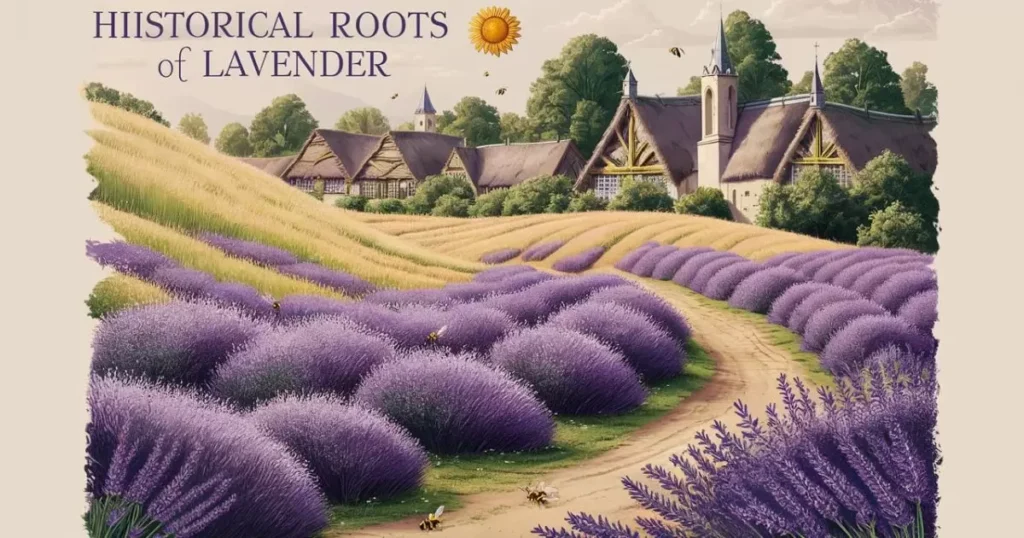Introduction
“Lavender blends rich history and symbolism with its modern role in design and wellness. Discover how this calming color influences our world today.”
People name the purple color after the lavender flower. Designers and decorators use it for its calming and soothing qualities, incorporating it into various designs and decor.” Lavender represents tranquility and grace, making it a popular choice in both personal and professional spaces.
This color has a rich history and significant symbolism, reflecting its role in different cultures over time. Understanding lavender’s evolution helps appreciate its modern applications better.
Discover the full spectrum of lavender’s impact in history, symbolism, and today’s use. Explore how this beautiful color can enhance your environment and convey messages through its subtlety and charm.
In this article, we will explore the historical roots of lavender, uncover its symbolic meanings, and examine its application in contemporary settings. Learn how this unique color can influence and inspire in various aspects of life.
Historical Roots of Lavender

People have cherished lavender since antiquity for its aromatic and therapeutic qualities.The ancient Egyptians used lavender in their mummification processes and as part of their cosmetic rituals, valuing its pleasant scent and preservative properties.
In ancient Rome, people popularized lavender as an ingredient in bathwater, believing it helped with relaxation and skin care. They spread its use throughout Europe, where people also used it in cooking and as a medicinal herb
During the Middle Ages, lavender was a staple in herbal medicine. Monks and nuns cultivated it in their monastic gardens and used it to treat various ailments, including anxiety and digestive issues. The plant’s versatility made it a common feature in households and gardens, symbolizing both healing and purity.
Symbolism Across Cultures
Lavender holds diverse meanings across different cultures. In Western cultures, lavender often symbolizes calmness and tranquility, reflecting its use in aromatherapy and spa treatments.In Victorian England, people associated lavender with devotion and love, often giving it as a gift to express affection.
In Eastern cultures, people sometimes link lavender to spirituality and meditation. They use it in rituals and ceremonies to promote a sense of peace and spiritual clarity.
In various cultures, people see lavender’s purple hue as a color of royalty and elegance, reflecting its historical use in noble clothing and decorative arts.
Lavender in Art and Literature
Lavender has inspired numerous works of art and literature due to its vivid color and distinctive scent. In art, it often symbolizes serenity and beauty, appearing in paintings and sculptures that aim to capture the essence of natural beauty.
Renowned artists like Claude Monet have included lavender fields in their landscape paintings, showcasing the plant’s visual appeal.
In literature, lavender frequently represents calm and healing. Writers often use it to evoke a sense of peace or nostalgia. In Shakespeare’s works, the symbol of remembrance and love highlights lavender’s emotional significance in the human experience.
Lavender in Fashion and Design
Lavender’s soft, calming shade makes it a popular choice in fashion and design. Its use in textiles and clothing reflects both elegance and subtlety.Designers often associate lavender-colored garments with sophistication and gentleness, making them a favorite in spring and summer collections.
In interior design, lavender adds a touch of serenity and refinement. Home decor commonly uses it to create a relaxing atmosphere, from wall colors to furniture accents.Its versatility allows it to complement a range of styles, from modern minimalist to classic.
Apanlokanmio.Com Unveiling A World Of Discovery
Psychological Effects of Lavender
Experts widely recognize the psychological benefits of lavender. Studies show that the scent of lavender reduces stress and promotes relaxation.Studies suggest that inhaling lavender essential oil can help with anxiety, depression, and insomnia, providing a natural alternative to pharmaceutical treatments.
Lavender’s calming effects are also evident in its use in therapy and wellness practices. Incorporating lavender into daily routines, such as through aromatherapy or meditative practices, can contribute to overall emotional well-being and mental clarity.
Lavender in Modern Wellness Practices
In modern wellness practices, people frequently use lavender for its therapeutic properties. Aromatherapists popularize essential oils derived from lavender to address a range of issues, from stress relief to pain management.
Lavender is also a common ingredient in skincare products, known for its soothing and anti-inflammatory effects.
In addition to using lavender for personal care, people feature it in holistic health practices. They often include it in herbal teas and supplements to promote relaxation and sleep.Its widespread use in these areas highlights its continued importance in maintaining well-being.
Culinary Uses of Lavender
Lavender’s unique flavor profile lends itself to various culinary applications.Chefs use it to infuse a subtle floral and herbaceous note into dishes, particularly in baked goods, desserts, and beverages. Lavender is a common ingredient in herb blends and flavorings for both sweet and savory recipes.
In addition to using lavender in cooking, chefs also employ it in culinary presentations. Its vibrant color and delicate aroma make it a popular choice for garnishes and decorative elements, adding an aesthetic touch to dishes and beverages.
Environmental Impact of Lavender Cultivation
Lavender cultivation has a range of environmental impacts. On the positive side, people know that lavender requires little water and tolerates drought, making it a suitable crop for areas with limited water resources.
Cultivating lavender can contribute to soil conservation and biodiversity by supporting various pollinators. However, large-scale lavender farming presents challenges.
The use of pesticides and fertilizers in some lavender farms can lead to environmental concerns, including soil degradation and water pollution. Sustainable farming practices are crucial for minimizing these impacts and promoting eco-friendly cultivation.
Lavender in Digital Design
In digital design, designers use lavender to create a soothing and elegant aesthetic. They often employ its calming qualities in web design, branding, and user interfaces to evoke a sense of tranquility and professionalism. Lavender hues are also popular in digital art for their visual appeal and ability to convey a serene atmosphere.
The use of lavender in digital design can enhance user experience by providing a gentle visual relief. Its application in social media graphics and online marketing helps brands communicate a message of calm and reliability, making it a valuable tool in the digital space.
Lavender in Architecture and Interior Design
Lavender influences architecture and interior design by enhancing ambiance and aesthetic appeal.
In architecture, designers can incorporate lavender-colored elements into exteriors and landscaping to create a serene and inviting atmosphere.
In interior design, designers often use lavender tones in wall colors, furniture, and textiles to promote a calming environment.The color’s ability to blend with various design styles makes it a versatile choice for creating relaxing and elegant spaces.
Lavender in Pop Culture and Media
Lavender has made its mark in pop culture and media, often symbolizing calmness and refinement. It appears in various forms of entertainment, including films, television shows, and advertising. Its presence in these media helps to convey messages of relaxation and luxury.
Fashion and beauty trends prominently feature the color lavender, associating it with elegance and sophistication.From celebrity styles to product packaging, lavender continues to influence and inspire modern aesthetics.
Lavender in Sustainable Fashion
Sustainable fashion has embraced lavender for its eco-friendly and aesthetic qualities. Lavender-dyed fabrics offer a natural alternative to synthetic dyes, contributing to sustainable production practices.
The use of lavender in fashion aligns with the broader movement towards ethical and environmentally-conscious clothing choices.
Designers use lavender in fashion accessories and design elements in addition to its use in textiles. Its gentle color and calming properties make it a popular choice for creating sustainable and fashion-forward items.
Challenges and Controversies Surrounding Lavender
Despite its many benefits, lavender cultivation faces several challenges and controversies. Issues such as pesticide use, water consumption, and labor practices can impact the sustainability of lavender farming. Addressing these concerns requires a commitment to ethical practices and sustainable agriculture.
Additionally, the popularity of lavender has led to concerns about overharvesting and biodiversity loss. Ensuring that lavender cultivation remains environmentally and socially responsible is essential for maintaining its positive impact.
Future Trends in Lavender Utilization

The future of lavender is promising, with trends pointing towards innovative uses and sustainable practices.
Emerging applications include biotechnology, where researchers are exploring lavender extracts for their potential in pharmaceuticals and cosmetic formulations.
Advances in genetic research may also lead to the development of lavender strains with enhanced properties, such as increased essential oil yield or improved resilience to pests.
Sustainability is becoming a key focus in lavender cultivation. Efforts are underway to develop more eco-friendly farming practices, including the use of organic fertilizers and integrated pest management.
The integration of lavender into urban green spaces and community gardens also represents a growing trend, contributing to environmental stewardship and local biodiversity.
Importance of colour:cckmvfcmc3m= lavender History, Symbolism, and Modern Applications
Understanding the history, symbolism, and modern applications of lavender provides valuable insights into its multifaceted role in human culture and daily life.
Lavender’s rich history, from its use in ancient medicinal and cosmetic practices to its presence in modern wellness and design, underscores its enduring significance.
ts symbolic meanings across various cultures highlight its universal appeal and importance in emotional and spiritual contexts.In contemporary settings, lavender’s applications extend into fashion, design, and technology, demonstrating its versatility and relevance.
By appreciating lavender’s historical and symbolic dimensions, we gain a deeper understanding of its impact and potential, making it an integral part of both our past and our future.
Additional Tips
- Incorporate Lavender in Your Routine: Consider using lavender essential oil in a diffuser to create a calming environment at home or add a few drops to your bath for a relaxing soak.
- Explore Lavender Recipes: Experiment with lavender in cooking by adding it to baked goods, teas, or even savory dishes for a unique flavor twist.
- Use Lavender in Design: Try incorporating lavender shades into your home decor, such as through cushions, curtains, or paint, to create a soothing and elegant space.
- Grow Lavender Sustainably:
- To cultivate lavender, use organic methods and be mindful of water usage to support environmentally-friendly practices.
- Stay Informed: Keep up with the latest trends and research on lavender to understand its evolving uses and benefits.
PROS AND CONS
| Aspect | Pros | Cons |
| Calming Effects | Lavender is widely recognized for its ability to promote relaxation and reduce stress. | Some individuals may experience allergic reactions to lavender essential oils or extracts. |
| Versatile Applications | Lavender’s uses span various fields, including wellness, design, and culinary, making it a valuable and adaptable resource. | The popularity of lavender has led to market saturation, potentially impacting its quality and price. |
| Eco-Friendly | Lavender can be cultivated with minimal water and supports biodiversity when grown sustainably. | Conventional lavender farming may involve pesticides that can impact the environment and health. |
| Culinary and Design Uses | Lavender enhances various dishes and design elements with its unique flavor and aesthetic appeal. | The strong flavor of lavender may not be suitable for all culinary applications. |
| Emotional and Spiritual Benefits | Lavender is used in therapies and wellness practices to enhance emotional and spiritual well-being. | Overuse in certain areas might lead to diminishing returns or negative effects, such as desensitization. |
ANSWER TO KEY QUESTION
1. What are the primary uses of lavender in modern wellness practices?
Aromatherapists use lavender primarily to reduce stress and improve sleep. Skincare products often contain lavender for its soothing properties, and herbal teas include it to promote relaxation.
2. How can I incorporate lavender into my cooking?
You can use lavender in baked goods, desserts, and beverages. Use it sparingly, as its flavor is quite strong. You can also add lavender to herb blends to give a unique twist to savory dishes.”
3. What are the environmental benefits of lavender cultivation?
People know lavender for its low water requirements and drought tolerance, which makes it suitable for areas with limited water resources. It also supports biodiversity by attracting pollinators.
4. How does lavender symbolism vary across cultures?
In Western cultures, lavender often symbolizes calmness and love, while in Eastern cultures, it may represent spirituality and meditation.
5. What are some sustainable practices for lavender farming?
Sustainable lavender farming practices include using organic fertilizers, integrated pest management, and minimizing water use. These practices help reduce the environmental impact and promote eco-friendly cultivation.
Lavender in Art and Literature
| Aspect | Description |
| Artistic Representation | Lavender is featured in paintings such as Claude Monet’s lavender fields, symbolizing beauty and serenity. |
| Literary Symbolism | In literature, lavender often represents calm and remembrance, highlighting its emotional and nostalgic significance. |
Conclusion
Lavender, with its deep historical roots, rich symbolism, and diverse modern applications, continues to captivate and inspire. From ancient medicinal practices to contemporary wellness and design, lavender’s versatility and enduring appeal make it a remarkable plant with a profound impact on our lives.
As we explore its uses and significance, we gain a greater appreciation for lavender’s role in enhancing our well-being, enriching our surroundings, and contributing to sustainable practices. By understanding and embracing the multifaceted nature of lavender, we can continue to celebrate and utilize this extraordinary plant in meaningful ways.










